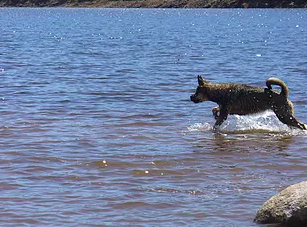When observing dog behavior, most of us know the difference between fear, play, and aggression. We correctly assume that a puppy is scared when his ears flatten against his head, his body weight shifts back, and his tail tucks so tightly it touches his tummy. We know a dog is having a great time when she is bouncing around, smiling with her mouth open, and play bowing toward her owner. And when a dog is baring his teeth, lunging, and growling, it’s a pretty safe bet that he is feeling confrontational.
Even though these behaviors look very different, they are easy to identify. But just like humans, dogs have a variety of smaller, more discrete gestures they display before going to extremes. It’s important to learn to identify these subtler behaviors so you can help your dog be more confident in new environments and avoid unnecessary run-ins with other dogs.
The first set of behaviors to be aware of are called displacement behaviors. These behaviors are a dog’s way of coping with the environment and include shaking off, licking of the lips, scratching, sniffing, stretching, and yawning. You might be thinking, “Wait, my dog yawns at night; isn’t he just tired?” Or, “My dog shakes off after a bath; isn’t he just wet?”
The answer in both cases is yes; however, I am not referring to these ordinary moments in time. These behaviors become displacement behaviors when they happen out of context. For example, your dog walks into the vet’s office and suddenly starts scratching himself. He begins pacing around the waiting room and then vigorously does a shake off. Your dog is not wet, nor does he have a skin allergy. So why is he shaking and scratching? This is your dog’s way of calming his nervous system, lowering his stress, and dealing with an environment he deems threatening.
I often hear comments like this from my clients: “He was fine and then suddenly, out of nowhere, he started barking and lunging.” After observing the dog’s behavior, I usually discover that the dog was not fine, rather he was holding it together before his behavior escalated. The dog was unsure of the situation, probably had a stiff body posture, and was most likely displaying a series of displacement behaviors before he started barking and lunging. I like to think of such behaviors as yellow flags before the dog starts displaying bright red flags, such as, lunging, growling, or retreating in fear.
I strongly encourage owners to start noticing these behaviors and, most importantly, when they take place. For example, I notice that my dog licks his lips when meeting another dog nose to nose and then does a shake off right after the greeting. Since these behaviors help him cope with situations, I can assume he is mildly stressed during dog meets. Knowing this, I can make the choice to keep leash greetings very short, helping to avoid negative experiences for my dog and preventing him from escalating beyond the yellow flags.
The other set of behaviors that are important to identify are avoidance behaviors, which I find go largely unnoticed by owners, and sometimes even other dogs. Many clients ask me, “What is the social etiquette when dogs meet on leash?” The most useful advice I can give is to pay more attention to the dogs’ body language rather than going by a distinct set of rules.
Most dog owners have been asked many times, “Can my dog say hello to your dog?” Before answering, take a look at both dogs and notice if they are offering avoidance behaviors, such as looking in the other direction, moving away from the other dog, avoiding eye contact, and/or sniffing the ground. These behaviors indicate that one or the other of the dogs, and perhaps both of them, would rather not say hello. So in those situations it can save you a lot of trouble to kindly reply, “Oh, sorry, he’s in training” and walk briskly past.
I encourage you to start observing your dog’s behaviors more closely. By noticing the simple and subtle behaviors discussed above, you can prevent unwanted, grumpy, or fearful interactions between your dog and others. Better yet, you can begin to understand what your dog is communicating through his body language, which will help create more ease and enjoyment in both your lives.

